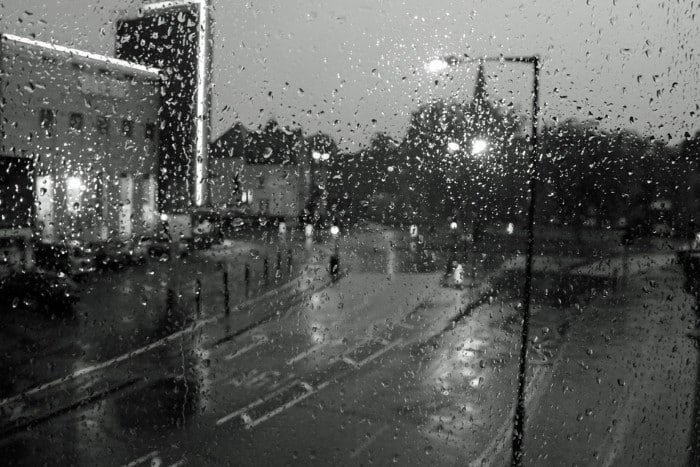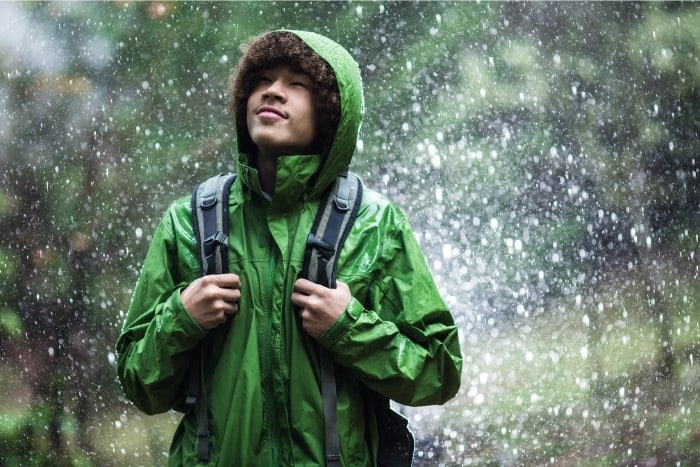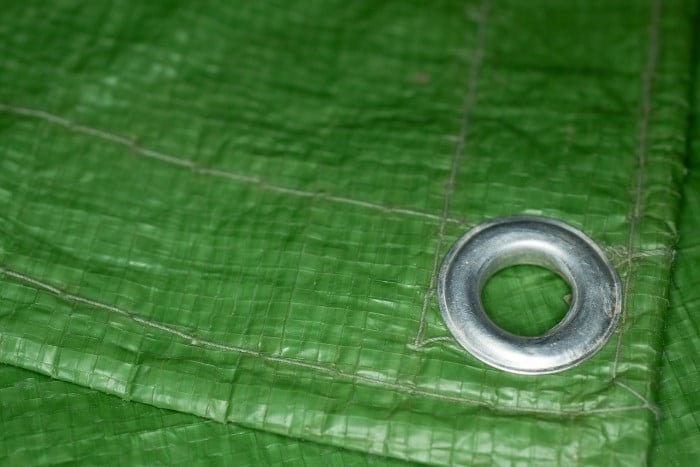The threat of rain is enough to make most campers cancel their trip, but you shouldn’t let a storm put you off just yet.
You can still have a fun, safe, and dry camping trip in the heavy rain if you bring the right equipment, pack the correct clothing, and learn a few tricks beforehand. Keeping dry depends on dressing correctly, setting your tent in the right place, and being aware of your surroundings.
Our comprehensive guide below covers the clothing you’ll need to remain comfortable on your trip, the extra equipment you may not have used when camping in good weather, and a few other tips and tricks for battling the elements.
Preparing to Camp in Heavy Rain
It may be tempting to cancel your upcoming camping trip if forecasts predict heavy rain, but there’s no reason to ditch your plans with the right preparation.
By making sure you take suitable clothing and equipment, and by brushing up on a few extra camping skills, you’ll be able to keep dry and enjoy a stormy outdoor experience that may even be more thrilling than a clear-weather trip.
It’s important to note that if an official weather warning recommends against camping in the area, you should always pay attention to any instructions given and follow all safety advice.
Otherwise, follow our camping guide below and your trip can go ahead as planned.

What to Wear
The first thing to consider when camping in heavy rain is what clothing to bring.
Choosing the right apparel will significantly impact your trip and can be the difference between a thoroughly enjoyable trip or a soggy nightmare.
The key takeaways here are going to be “quality” and “suitability.” Having the right clothes and footwear doesn’t mean breaking the bank on the latest gear.
However, remember that camping in heavy rain will take a greater toll on your stuff.
Spending a little more on higher-quality clothing means it’s less likely to need replacing and can save you money in the long run.
1. Base Layers
Proper layering is the most crucial thing to remember when choosing the right clothing for spending time in heavy rain.
Picking the right layers makes it easier to adjust your body temperature and replace wet layers with dry ones.
Starting with your base layer, you’ll need to wear something light and breathable.
It’s also important that your base layer can wick away any moisture from sweat or rain into the next layer to keep your skin dry.
While cotton may be light and breathable, it makes for a terrible base layer due to the amount of water it absorbs.
Synthetic materials like polyester are a solid choice due to their wicking properties, although quality can vary dramatically.
They’re light, quick-drying, and breathable but aren’t great at keeping you warm if they get wet, and not everybody likes the synthetic feel of polyester against their skin.
Our number one material for a base layer is undoubtedly Merino wool. The all-natural fiber is naturally insulating but also fantastic at wicking away sweat.
Merino wool offers superb breathability while feeling extremely soft and comfortable against the skin and will continue to keep you warm if it gets wet.
It also naturally absorbs body odor, allowing you to wear it for longer without washing, making it perfect for camping.
If the weather is cold enough to warrant a base layer for your legs, we’d also go with a pair of Merino wool thermal leggings.
2. Middle Layers
Middle layers are fairly straightforward when it comes to camping in heavy rain. Wool is your best bet as it’s a strong insulator and a good water-repellant.
The thickness of your middle layer will come down to how warm or cold the weather is and how active you plan to be on your trip.
A simple wool hoodie or zip-up fleece is ideal.
Whatever you choose, make sure you avoid down-insulated clothing as these absorb a lot of water, become heavy and uncomfortable, and can take forever to dry out.
For your legs, you’ll want a pair of durable, weather-resistant hiking pants with enough room underneath for a base layer, if required.
3. Outer Layers
For a jacket, you’ll want something lightweight, breathable, and waterproof.
A hardshell jacket is lighter and generally more water-resistant than a softshell jacket, often featuring taped seams to prevent even the heaviest rain.
However, if you’re going to be fairly active on your trip, a softshell jacket will offer better durability and flexibility and is better at drawing moisture away from your body.
Whichever option you go for, bear in mind that the water-resistant properties of either will degrade over time, and you will need to re-waterproof them regularly.
You’ll want to invest in a pair of waterproof pants to remain completely dry in heavy rain.
These should fit comfortably over the top of any other layers and, as with your jacket, will need regular re-waterproofing.
Another option, which may seem like a left-field choice, is to go with a pair of hiking shorts.
Your legs will dry off more quickly if they’re bare, so if the rain is heavy but the temperature is mild, they can be a great lightweight alternative to pants.

4. Footwear
Your feet are arguably the most important things to keep warm and dry when camping, so pick sturdy, water-resistant shoes and pair them with woolen socks – again, Merino wool is our favorite.
You can even find specialist waterproof wool socks that keep your feet warm and dry all day while wicking away any sweat.
Your choice of shoe will depend on your type of trip. If you plan on doing lots of walking, you’ll want a robust yet comfortable, waterproof hiking shoe.
If you spend more time around a traditional campsite, we recommend a pair of rubber boots.
Another strange but popular choice for campers is a solid rubber flip flop or pair of crocs.
You likely won’t want to wear them all day, but they’re extremely useful when you need something completely waterproof to quickly slip on to move around your campsite.
Camping Equipment
Next, we’ll look at how to assess the suitability of your current gear and cover the equipment you may have left off your list on previous dry camping trips.
When it’s raining, these are things you should never camp without.
1. Tent
Most modern, synthetic tents come with an external, waterproof fly sheet that should stand up to heavy rain; however, you will eventually need to re-waterproof it.
On the other hand, canvas tents don’t necessarily require external waterproofing but won’t be completely water-resistant when brand new.
When cotton fibers get wet, they shrink, and the canvas weave tightens, which ultimately helps improve its water-resistant capabilities.
You can “season” a new canvas tent by setting it up outside, hosing it down, and letting it dry a few times before taking it out in heavy rain.
You should always remember to never pack away a canvas tent when wet, as this can lead to mold growth and degradation of the material.
If you have to take it down when wet, fold the canvas loosely until you get the chance to air dry it properly.
Synthetic tents should also be dried before storage but won’t absorb moisture as easily, so they can be packed away for a short time before being dried out completely.
2. Sleeping Bag
Hopefully, you won’t need to worry about your tent leaking and your sleeping bag getting wet during the night, but there’s always a chance it could get wet at some point during your trip if the weather is poor.
We suggest avoiding down sleeping bags, as they become very heavy and can take days to dry out.
Waterproofing a sleeping bag is doable, although not particularly effective.
The multiple seams of a sleeping bag mean it won’t remain water resistant, and the coating affects breathability, an important feature for a comfortable night’s sleep.
If camping regularly in extreme conditions, such as prolonged storms or even snow, you could purchase a bivy sack for use as a waterproof outer layer.
3. Bags
A waterproof bag cover is the way to go if you’re camping light with just a backpack.
These are relatively cheap, and many modern backpacks even come with one included.
They’re simple to put on and take off and usually come with an elasticated edge to form a tight, water-resistant seal around your bag.
If you’re taking more gear, dry bags are invaluable.
You can find dry bags with capacities as low as five liters and larger than thirty liters, so there’s a suitable option for every need, including bags with backpack-like straps.
You can even buy handy dry pouches for your phone that hang around your neck and are completely submersible, making them handy for water sports like kayaking and camping in the rain.
Lastly, take lots of spare plastic bags for your wet gear as it’s crucial that wet clothing is kept apart from dry.
Anything that can’t be dried on your trip should be secured in a plastic bag until you can wash and dry it back home.
4. Tarpaulin
A durable, waterproof tarpaulin is your best friend if you’re camping in heavy rain. We highly suggest taking a minimum of two with you.
First, you’ll want to use it as a groundsheet under your tent to prevent water from wicking up from the ground and soaking into your floor.
The second tarp is to create a sheltered area.
How you set up your tarp and the area it can cover will depend on your camping location; if you’re fortunate enough to have a spot among the trees, you may even be able to create a cover large enough to set up your tent under.
Once your tent is up, you can move the tarp to create a sheltered spot for relaxing, cooking, and drying clothing adjacent to your sleeping quarters.
Remember to pack enough paracord and extra tent stakes to secure your tarp properly, and, if you’ve not had much practice, make sure you have a go at setting up different tarp configurations at home in dry weather before your trip.
Trying to figure out how to create shelter for the first time in the pouring rain is not an enjoyable experience.

5. Entertainment
If the rain is too heavy for outdoor activities, you’ll want to pack a few things to pass the time while you wait for the weather to improve.
You may want to avoid books, and electronic devices as neither of these play well with water, at least when small children are involved.
A pack of playing cards is invaluable due to its portability and the huge range of age-appropriate games that can be played with them.
You can also find compact travel and card-based editions of classic games such as Clue, Monopoly, and Scrabble that are superb for passing hours at a time.
6. Extras
There are always a few extra items worth having on hand in inclement weather.
A roll of duct tape can be invaluable if you need to make a quick, waterproof repair on any of your equipment, and the risk of something getting damaged is much higher in heavy rain and high winds.
We also recommend taking a few extra blankets if bad weather is forecast, as they’re useful for keeping cozy at night and warming up if you get soaked during your trip.
It’s worth taking quick-dry towels, as they take up very little space and dry rapidly, meaning you can use them frequently on longer excursions.
How to Set Up Camp in Heavy Rain?
You’ve arrived at your campsite with all the right clothing and equipment, but the final step is ensuring you set up camp properly to avoid getting soaked.
Otherwise, all your preparation will go to waste.
1. Location
When pitching your tent, pay close attention to the ground.
If you set your tent up at the bottom of an incline, the rain will run down and pool directly below your tent, so your best bet is to find higher ground.
If you’re staying at a campsite with camping facilities, you’ll want to be situated as close to them as possible to avoid getting wet traveling back and forth from your tent.
Fortunately, you’re likely to find a lot of space in poor weather, less informed, and the adverse conditions will put prepared campers off.
If you’ve driven to the campsite and are allowed to pitch near your vehicle, remember you can position your car or van next to your tent to act as a windbreak to provide extra protection from the elements.
2. Setting Up Your Tent
As mentioned previously, the first thing you’ll want to do is lay down your waterproof ground sheet before setting up the inner part of your tent.
When it’s time to set up the waterproof fly sheet, do everything you can to ensure it doesn’t touch the inner layer, as any contact will transfer moisture to the inside of your tent.
The same rule applies to your belongings touching the inner layer; even with a waterproof outer covering, condensation will form inside your tent overnight and then transfer to dry clothing or sleeping bags.
Many fly sheets come with air vents that should be positioned in a way that won’t allow water to enter the tent when ajar.
Whenever you’re not using your tent, try and keep these open to prevent condensation from forming; otherwise, your belongings will become damp, and at night you’ll have to deal with breathing stale air.
Lastly, ensure your tent remains a “dry quarantine zone,” meaning any wet items are banned from being taken inside.
This will ensure dry items stay that way, and you’re less likely to track mud and rain into your clean sleeping area.
3. Cooking
For cooking, first, you’ll want to use your tarp to create a sheltered “kitchen” area.
A camping stove is your best option in poor weather, as it’s generally not recommended to light a fire under a tarp.
To cut down on your cooking time, look into buying packs of MREs (Meal, Ready to Eat).
These are essentially military rations and generally excellent value for money.
Ration packs are guaranteed to be quick and simple to prepare, offer a huge variety of meal choices, and are specifically designed to meet our daily caloric requirements.
If you need to start a fire under your tarp, keep it small – no larger than fourteen inches across – and ensure you have at least six feet of clearance between the flames and any material.
Not only does this reduce the risk of your tarp igniting, but it ensures enough airflow to prevent any danger of smoke inhalation.
Waterproof matches and tinder are a must, and a camping hatchet is useful for chopping at damp logs to get to the dry wood underneath.

Conclusion
Hopefully, this guide has shown how the right gear and proper preparation mean there’s little reason to cancel your upcoming camping trip due to heavy rain.
It may take a little extra time and money.
Still, the ability to camp in adverse conditions is a useful skill, whether you’re aware of the forecast ahead of time or need to react quickly to an unexpected change in the weather.
